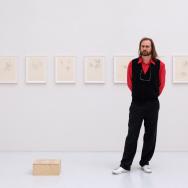The philosopher’s hut is a space designed for privacy, where exile and thought go hand-in-hand. A new exhibition at the Neubauer Collegium for Culture and Society invites the public into that habitat, exploring the work of three 20th-century philosophers who did some of their most important thinking in conditions of exile.
Theodor Adorno was forced into exile soon after the Nazis rose to power, an uprooting that shaped his thought for the remainder of his life. Martin Heidegger and Ludwig Wittgenstein imposed exile on themselves by constructing and inhabiting simple wooden cabins where they were free to think and write apart from society. Scaled reconstructions of those cabins, along with original sculptures and archival photographs, will be on view in the gallery as part of the exhibition, called Hutopia, which opens April 25 and runs through Sept. 6.

The Neubauer Collegium, a research center that aims to integrate creative expression and academic inquiry, also has organized a series of public events to consider the philosophers’ lasting influence. Dieter Roelstraete, curator at the Collegium, recently spoke about the uncanny links between Heidegger and Wittgenstein, the profound relationship between place and thought, and the cultural urge to unplug.
What is so compelling to you about exile in relation to philosophical inquiry, in these three cases and generally?
I’ve long been interested in the relationship between where something is thought and what is being thought there. The more pressing question might be why we are being led to think about the relationship between philosophy and exile at this particular moment in time. The answer lies in the fact that this moment is so relentlessly demanding, so frantically networked, and so socially and politically volatile. I think we can all more or less instinctually agree that to think clearly, sharply and slowly, we might have to disconnect. As social media and communications culture exerts an ever-tightening grip on our lives and minds, dreams of dropping out and going “off the grid” gain more and more traction. The fear of missing out (FOMO) is slowly being replaced—admittedly, primarily in very privileged quarters—by the joy of missing out. That, in a nutshell, is what Hutopia is about, in all its awareness of the ambiguities and misguided romanticism of this particular vision.
Now, to return to the concrete cases of our three protagonists: The stories of Heidegger and Wittgenstein are much more closely intertwined than that of Adorno. Exile was not something Adorno voluntarily chose, but it did turn out to be the “right” condition for his thought to develop. On the other hand, Heidegger and Wittgenstein were not only exact contemporaries who respected each other’s work from a safe distance, but they both built these cocoons for thinking deep thoughts right around the same time, and for comparable reasons that reveal an underlying reactionary, anti-modern instinct. Wittgenstein, the tormented scion of a wealthy Austro-Hungarian industrialist family who could not bear the niceties of social life in Vienna and Cambridge, fled to a remote rural nook of Norway’s fjords in search of a simpler life. Heidegger was the modest, diminutive son of a middle-class church official in the Swabian provinces of Germany whose retreat to a peasant cabin in the countryside has something exquisitely staged and therefore inauthentic about it. And that’s where the seeds for Being and Time were sown, much like Wittgenstein’s Tractatus was shaped in no small measure by the experience of living at the edge of the world. Very cinematic, is it not?
In any case, I had long been struck by this uncanny parallel in the lives of the two titans of 20th-century philosophy. You can almost imagine them sitting in their respective huts at the exact same time, thinking thoughts that would lead to radically different outcomes. But, strangely enough, they do end up speaking to each other in a way.
You commissioned Chicago-based artist John Preus (MFA’05) to construct scaled versions of these huts and to (very schematically) reimagine an Ian Hamilton Finlay sculpture titled Adorno’s Hut for the show. How do you plan to activate the space, and what do these different uses suggest about the relationship between social experience and artistic expression?
Something that has always interested me about Heidegger’s hut in particular is the fact that the structure is almost as well-known for being inaccessible as it is for having survived its one-time occupant. The Heidegger family is notoriously reticent and almost aggressively indifferent to the interest that this modest dwelling continues to elicit among philosophy enthusiasts; I’d hardly be exaggerating in calling it a place of pilgrimage. This anxious insistence on family privacy—you should see the size of the “Verboten!” signs outside the little pocket of trees along the country road where the hut is sited—probably has some relation to the philosopher’s Nazi past. But it also contributes to the mystique of the image we have of deep thinkers as modern-day desert saints spouting oracular wisdoms in inhospitable places, which is a romantic fiction I am interested in complicating and problematizing. And I want to do so by opening up these quintessentially solitary structures for mixed social use (starting, for instance, with a class that I’ll be teaching on the subject—and partly also in the subject).
The opening of Hutopia will be a social affair, of course, so it will be interesting to see people crowd around our hermitages. The preeminent Wittgenstein biographer Ray Monk will speak at the opening, we’ve organized a discussion in May focused on Heidegger, and we will explore Adorno’s music at a performance in September. I am very keen on seeing these philosopher’s huts become activated; they are not shrines, and I’m not sure whether they’re going to be all that conducive to insular thought. But the overall idea is to highlight the deeply and unquestionably dialogical nature of a type of mental activity that is often thought of as monolithically monological.
The exhibition itself will serve as a sort of dialogue among artists—perhaps complicating, in a similar way, the romantic myth of the artist as a solitary genius. Who else besides John Preus is featured in this show, and what have they brought to the discussion?
One of the works in the exhibition will be a large-scale color photograph, made by the British artist Guy Moreton, of the stone base outside the village of Skjolden, Norway, on which Wittgenstein’s hut once stood. (Funnily enough, that hut is now being rebuilt on the very same spot—so Guy’s picture, taken in 2005, depicts a space that is no longer there.) The London-based Polish artist Goshka Macuga has made three fully functioning vases, modeled after the heads of the three philosophers at the heart of our narrative, that are supposed to hold freshly cut flowers. This work was commissioned for Machines à Penser, a show I organized for the Fondazione Prada in Venice in conjunction with the 2018 Biennale Architettura, which is the basis for the Hutopia show. There will be a suite of photographs made by the German photojournalist Digne Meller Marcovicz in the late 1960s chronicling Heidegger’s daily life in and around his storied hut.
You studied philosophy as a college student at the University of Ghent, and you’ve made pilgrimages to the actual sites of these remote huts. Is it fair to say that this project has deep personal meaning to you?
As a curator I am particularly interested in the notion of art as a philosophical, intellectual pursuit. It’s a lifelong passion that I keep returning to time and again to sharpen my curatorial thinking, which can veer towards the bookish at times. Adorno, Heidegger and Wittgenstein have accompanied me steadfastly through much of my development as a writer, curator and critic. Wittgenstein continues to inspire an almost old-fashioned passion of fandom. I mean, I even got a number of one of his Tractatus paragraphs tattooed on my left shoulder! But that was obviously a long time ago.
How does this show fit within the broader context of the exhibitions program you’re developing as the Neubauer Collegium curator?
Above all, this exhibition—and the ones that precede and will follow up on it—are “love letters,” pure and simple, to the idea of art. Looking back at my first year at the Neubauer Collegium, a curatorial affinity with print culture and the world of the book—a quintessentially Hyde Park preoccupation—stands out. The Cecilia Vicuña show, Palabrarmas, included a series of drawings that act as visual poems. The second exhibition featured a video in which the Slovak video artist Anna Daučíková moved around classics of Russian literature as if they were characters in a play. The third installment, a sculptural installation by Jason Dodge, included a reading and recording of an original poem written by Ishion Hutchinson for the occasion.
The Hutopia project clearly continues along that trajectory, while simultaneously opening up our exhibition program toward a more actively social dimension. The show is well-timed, for instance, to act as a modest, homegrown preface to the upcoming Chicago Architecture Biennial. Also, isn’t the Neubauer Collegium itself a sort of philosopher’s hut—or maybe a model for a new kind of hut where people can think together?

















